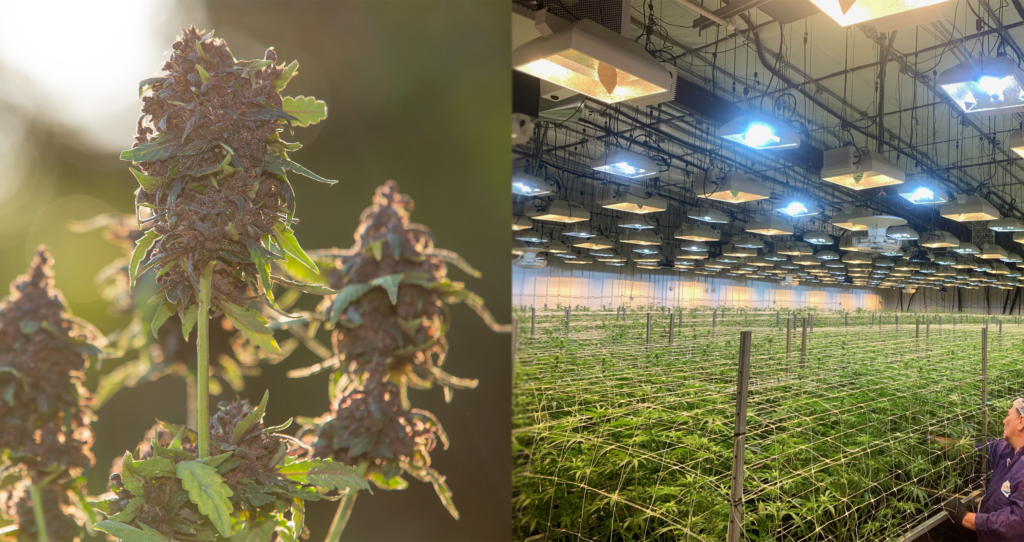
- February 28, 2024
- 0 comments
- 568 Views
Cannabis can be cultivated outdoors, in an open field, or indoors, either within the protection of a greenhouse or in a grow room, a sophisticated indoor controlled growing space that uses artificial light and other inputs. Deciding which growing method to use depends on climatic conditions, available resources and cost.
Differences between growing methods
The primary difference between outdoor and indoor cannabis cultivation is the level of control growers have.
Outdoors, cannabis is grown like most traditional agricultural crops: in soil, often unmulched, on wide row spacings.[1] This method taps into and depends on the soil’s free resources such as heat, humidity, rainfall and natural sunlight. For these reasons, it is usually the more cost-efficient growing method.
However, outdoor crops are also at the mercy of Mother Nature. Growers have little control over several factors, including how much water and heat the crop receives, the soil quality and related conditions, damage from severe weather, pests, soilborne diseases and other animals.
Indoors, plants are spaced densely together in what’s known as a “sea of green” (SOG).[2] In greenhouses, the crop can still capitalize on the sun’s light and heat; otherwise, it is up to the grower to provide the rest of the resources it needs. Grow rooms require artificial light.
Thus, indoor is more costly than outdoor production, although it allows growers who aren’t in an ideal climate to grow cannabis if they have the necessary resources and space for indoor production. It also gives growers almost total control over every factor that influences the cannabis crop. They can choose between growing the plants in soil or in artificial, soilless mediums. They can determine when and how much to irrigate the plants and can more easily regulate temperature and humidity, not to mention introduce CO2 into the environment.

Differences between indoor and outdoor cannabis
The choice of cultivation method—outdoor versus indoor, greenhouse versus grow room—also affects the cannabis crop.
With more space to grow, outdoor cannabis can reach maximum growth, often growing very large compared to indoor cannabis. This results in a median yield of 13.7 square feet per pound (sf/lb).[3] Outdoor cannabis also tends to grow large buds with looser flower consistency. Its flavor profile is more pungent due to rapid terpene development from natural sunlight. One study found that naturally grown cannabis tends to have more sesquiterpenes—which contribute better fragrance and flavor, and more healthy benefits, than simpler terpenes—as well as fewer oxidized and degraded cannabinoids.[4]
Due to the limited space, indoor cannabis tends to be shorter, bushier plants with smaller, more tightly packed buds that are bright in color and produce high cannabinoid levels. Cannabis grown in highly controlled environments such as grow rooms typically yield around 2.8 sf/lb, while greenhouse-grown cannabis yields 5.8 sf/lb.[5]
Not only are the yield differences between indoor and outdoor cultivation significant, but they also have different crop cycles. Outdoor cannabis cultivation is limited to one or two crop cycles per year, while indoor cannabis production can produce five or more crops per year if the plants are on a sixty- to seventy-day growing cycle.

Other considerations
While climate and resources—both land and capital—play a large role in determining which cultivation method to choose, growers should also consider the purpose of their production. If they’re growing cannabis for medicinal purposes, indoor cultivation may be a better option, as the higher production control results in a more consistent end product.
It’s also worth noting the discrepancy in research on cannabis grown outdoors versus indoors. Because indoor production is the most popular growing method for cannabis, most recent studies focused on optimizing efficiency and maximizing yield , as they’re protected from cross-pollination of male cannabis plants.
Finally, we need to consider the ecological effects of each growing method. Cannabis is a water-intensive crop. Outdoor cultivation can contribute to soil erosion, while indoor cannabis production is one of the most energy-intensive industries in the US.[6] If sustainability is a priority, growers need to consider which growing method and practices will limit their environmental impact.
Indoor versus outdoor cannabis cultivation
Parameters
Indoor
Outdoor
Control
Total control of all growing factors
Less control and dependent on external factors
Climatic conditions
Can be controlled and grown year-round
Dependent on environment
Cost
Relatively high, as it requires investing in the facility
Lower operational costs
Plant density and size
Small bushy plants, fewer per square meter
Huge plants and more per square meter
Bud appearance
Small, tightly packed buds bright in color
Large buds with looser flower consistency
Growing medium
Versatile growing medium options offering total control from soil-borne diseases
Soil characterized by natural biodiversity and benefits like nitrogen fixation
Yield
Median yield metrics are 2.8 square feet per pound (sf/lb) for grow rooms (7.2 million square feet of canopy in cultivation), 5.8 sf/lb for greenhouses (13.7 million square feet canopy)
13.7 sf/lb for outdoor operations (7.5 million square feet per canopy)
Cannabinoids and terpenes
High cannabinoid levels
Potent flavor profile
Product consistency
More consistent end product, especially if you’re growing for medicinal purposes
Growing different varieties
Cheaper and easier established environments suitable to different varieties
Varieties dependent on natural conditions, particularly climate
The Emerald Harvest Team
[1] Mills, Evan. (2022). Contrary to Conventional Methods, Best Practices for Cannabis Cultivation Result in Less Intensive Land and Water Use for Outdoor than for Indoor Farming.
[2] Ibid.
[3] Ibid.
[4] https://doi.org/10.3390/molecules28020833
[5] Mills, Evan. (2022). Contrary to Conventional Methods, Best Practices for Cannabis Cultivation Result in Less Intensive Land and Water Use for Outdoor than for Indoor Farming.
[6] https://doi.org/10.1186/s42238-021-00090-0